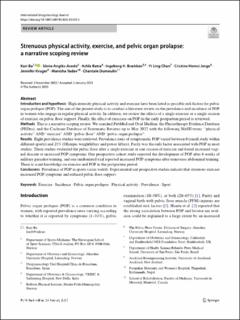| dc.contributor.author | Bø, Kari | |
| dc.contributor.author | Anglès-Acedo, Sònia | |
| dc.contributor.author | Batra, Achla | |
| dc.contributor.author | Brækken, Ingeborg Hoff | |
| dc.contributor.author | Chan, Yi Ling | |
| dc.contributor.author | Jorge, Cristine Homsi | |
| dc.contributor.author | Kruger, Jennifer | |
| dc.contributor.author | Yadav, Manisha | |
| dc.contributor.author | Dumoulin, Chantale | |
| dc.date.accessioned | 2023-05-03T19:30:09Z | |
| dc.date.available | 2023-05-03T19:30:09Z | |
| dc.date.created | 2023-03-31T08:28:04Z | |
| dc.date.issued | 2023 | |
| dc.identifier.citation | International Urogynecology Journal. 2023, Artikkel 05450-3. | en_US |
| dc.identifier.issn | 0937-3462 | |
| dc.identifier.uri | https://hdl.handle.net/11250/3066066 | |
| dc.description | This article is licensed under a Creative Commons Attribution 4.0 International License, which permits use, sharing, adaptation, distribution and reproduction in any medium or format, as long as you give appropriate credit to the original author(s) and the source, provide a link to the Creative Commons licence, and indicate if changes were made. The images or other third party material in this article are included in the article's Creative Commons licence, unless indicated otherwise in a credit line to the material. the article's Creative Commons licence and your intended use is not permitted by statutory regulation or exceeds the permitted use, you will need to obtain permission directly from the copyright holder. | en_US |
| dc.description.abstract | Introduction and hypothesis: High-intensity physical activity and exercise have been listed as possible risk factors for pelvic organ prolapse (POP). The aim of the present study is to conduct a literature review on the prevalence and incidence of POP in women who engage in regular physical activity. In addition, we review the effects of a single exercise or a single session of exercise on pelvic floor support. Finally, the effect of exercises on POP in the early postpartum period is reviewed.
Methods: This is a narrative scoping review. We searched PubMed and Ovid Medline, the Physiotherapy Evidence Database (PEDro), and the Cochrane Database of Systematic Reviews up to May 2022 with the following MeSH terms: “physical activity” AND “exercise” AND “pelvic floor” AND “pelvic organ prolapse”.
Results: Eight prevalence studies were retrieved. Prevalence rates of symptomatic POP varied between 0 (small study within different sports) and 23% (Olympic weightlifters and power lifters). Parity was the only factor associated with POP in most studies. Three studies evaluated the pelvic floor after a single exercise or one session of exercise and found increased vaginal descent or increased POP symptoms. One prospective cohort study reported the development of POP after 6 weeks of military parashot training, and one randomized trial reported increased POP symptoms after transverse abdominal training. There is scant knowledge on exercise and POP in the postpartum period.
Conclusions: Prevalence of POP in sports varies widely. Experimental and prospective studies indicate that strenuous exercise increased POP symptoms and reduced pelvic floor support. | en_US |
| dc.language.iso | eng | en_US |
| dc.subject | exercise | en_US |
| dc.subject | incidence | en_US |
| dc.subject | pelvic organ prolapse | en_US |
| dc.subject | physical activity | en_US |
| dc.subject | prevalence | en_US |
| dc.subject | sport | en_US |
| dc.title | Strenuous physical activity, exercise, and pelvic organ prolapse: A narrative scoping review | en_US |
| dc.type | Peer reviewed | en_US |
| dc.type | Journal article | en_US |
| dc.description.version | publishedVersion | en_US |
| dc.rights.holder | © The Author(s) 2023 | en_US |
| dc.source.pagenumber | 12 | en_US |
| dc.source.journal | International Urogynecology Journal | en_US |
| dc.identifier.doi | 10.1007/s00192-023-05450-3 | |
| dc.identifier.cristin | 2138726 | |
| dc.description.localcode | Institutt for idrettsmedisinske fag / Department of Sports Medicine | en_US |
| dc.source.articlenumber | 05450-3 | en_US |
| cristin.ispublished | true | |
| cristin.fulltext | original | |
| cristin.qualitycode | 1 | |
